Puget Systems Genesis II Quiet Workstation Review
by Dustin Sklavos on May 22, 2013 12:01 AM EST- Posted in
- Systems
- Xeon
- Puget Systems
- Workstation
- desktops
Workstation Performance
Unfortunately, despite its workstation pedigree, the Puget Systems Genesis II Quiet suffers mightily in SPECviewperf due to its consumer-grade GeForce GTX 670. For gaming that card is fine, but workstation applications place higher and different demands on the graphics hardware and drivers. As you'll see, though, the Genesis II Quiet will need a workstation card to fulfill its potential.
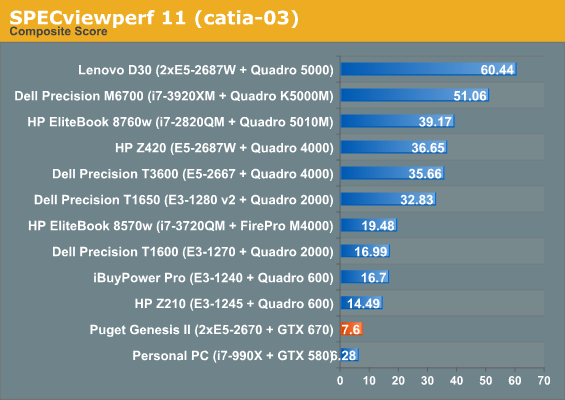
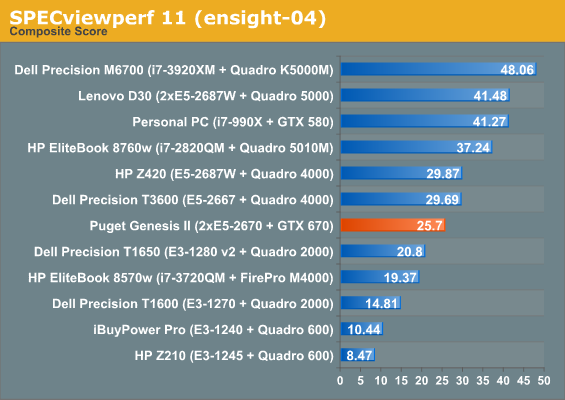
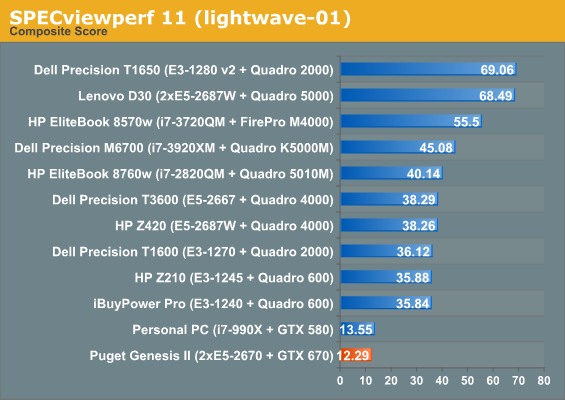

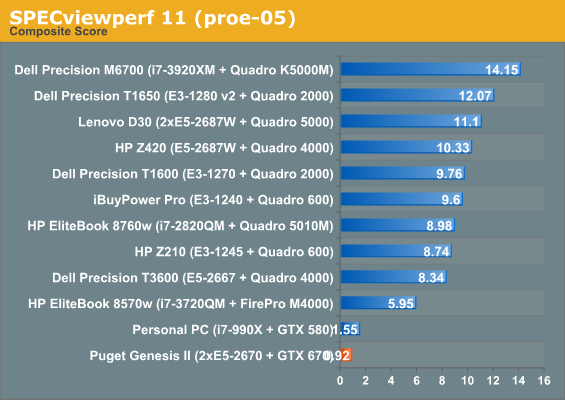
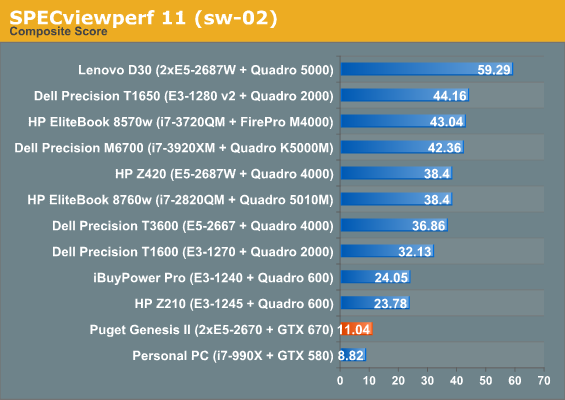
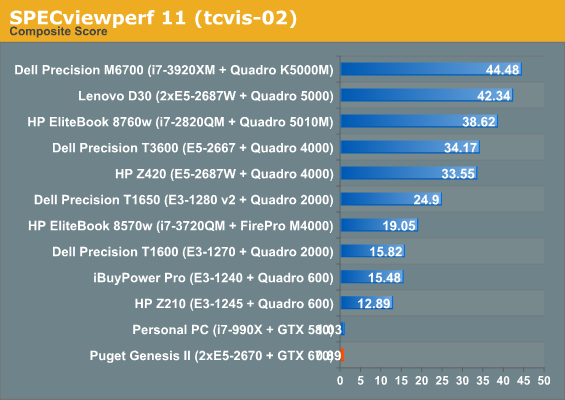
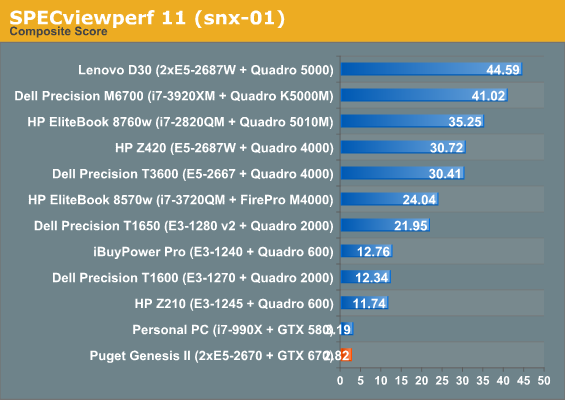
It's not even a little bit slower, it's worlds slower. Compare the performance of the GTX 670 to even the entry-level, $145 Quadro 600. With rare exception, even 96 last-generation CUDA cores are able to produce tremendous performance gains with the right drivers over a beast like the GTX 670. Even if you're a prosumer, you owe it to yourself to jump over to a workstation card if your workload demands one.
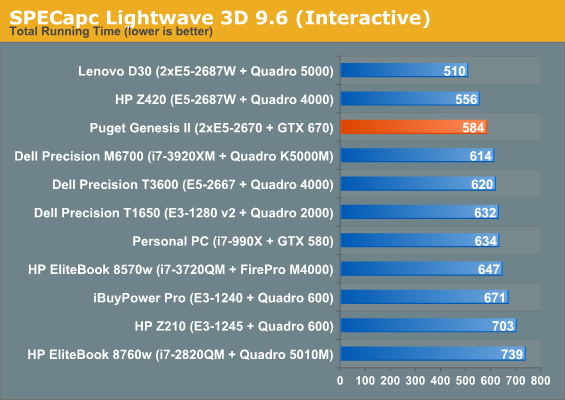
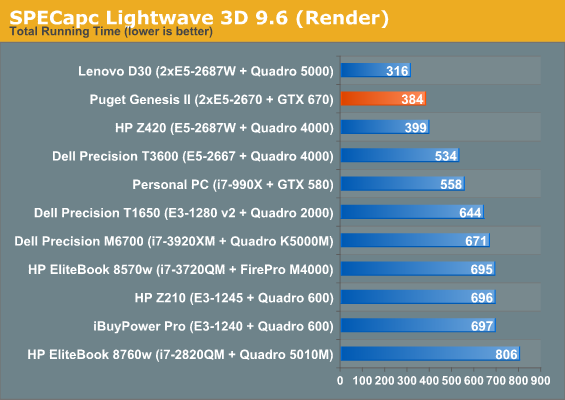
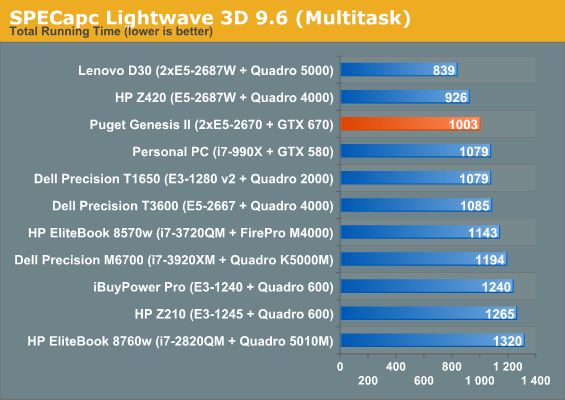
Lightwave is a bit kinder to the Genesis II Quiet, limited primarily by CPU performance. There's a point of diminishing returns that Lightwave reaches, and it still seems to respond well to high core clocks. Still, if you use Lightwave, you owe it to yourself to run an octalcore processor. Whether or not you need a second one is debatable, but at least a single one is enough to produce a jump in performance.










18 Comments
View All Comments
bromega - Wednesday, May 22, 2013 - link
honestly, the cable management looks pretty scrappy for a boutique buildgipper51 - Wednesday, May 22, 2013 - link
Care to test an incredible workstation? Try one of the overclocked systems from Boxx Technologies.like their 4920 Xtreme or one of their 4+GHZ dual Xeon systems. We are using the 4920 Xtreme systems for Autodesk Revit / 3Ds Max at a medium-sized architectural firm and it absolutely screams, and it better for $8K. Coming from hexcore Xeon Z800 systems....staggering difference.Boxx is boutique, but their clients include Disney, Boeing, BMW, Mercedes, NASA, Pixar, Dreamworks, US Dept. of Defense, and dozens of others. Top notch stuff.
SodaAnt - Wednesday, May 22, 2013 - link
Really now? I just went to their website, and for a computer with the exact same configuration as the product being reviewed here would cost $10,000. And that wouldn't even be for a super quiet computer, so I fail to see how that would be a better computer.Plus, the claim about the "4+ GHZ dual Xeon system", I fail to see how that is true. The processor they list has a max turbo frequency of only 3.8GHz, so unless they are overclocking a workstation, there's no way that can be true. And if they ARE overclocking a workstation, that's a dangerous road to go down.
gipper51 - Wednesday, May 22, 2013 - link
Yes they are overclocking the Xeons to a mild degree. Whether it's a good idea or not, they've been doing it for a long time. I doubt they would have the client list they do if these machines were not reliable.The 4920 Xtremes we are running have hexcore i7 CPUs at 4.5ghz and you can barely hear them. Not silent, but they are quieter than our previous HP workstations.
SodaAnt - Wednesday, May 22, 2013 - link
Its beside the main point though, that if you want the same machine that was reviewed here, Boxx would charge $3,000 more. Further, how do they overclock them anyways? Part of the other problem is that overclocking SB-E xeons isn't an easy task, and tends to be more unreliable because of the multiplier lock. I somehow feel they tweaked the frequencies by about 5% just so they could advertise that they are "4GHZ+"JarredWalton - Wednesday, May 22, 2013 - link
SNB-E allows you to run the BCLK multiplier at various settings, so while SNB-E is CPU multiplier locked it's still possible to set the BCLK to 1.25x or 1.66x instead of the default 1.00x. So basically it's easy to get a 25% overclock, and if your hardware can handle it a 66% overclock is also possible. You can also lower the multiplier however, so running with 1.66x and a 27X CPU multiplier (as opposed to the default 29X on the E5-2690) would get you the above mentioned 4.5GHz.MattKatz - Thursday, October 9, 2014 - link
For a workstation, I'd get something like Dell Inspiron i3847-5078BK (loved by consumers, see http://www.consumertop.com/best-desktop-guide/ for example). Definitely not the Genesis II Quiet.Rick83 - Wednesday, May 22, 2013 - link
I suppose this board won't support full AMT 7.1, due to the wrong LAN chipsets being used?But - does any S2011 board support KVMoIP via AMT? In the 1155/1156 Xeons this supposedly requires the integrated graphics - without those being present on the -E platform, a quick googling couldn't uncover this information.
tunaman - Wednesday, May 22, 2013 - link
im sure you could build for cheaper, 6000+ (when you add the extras) for something special.nice concept, but i would rather just take and build the crysis 3 machine from may 2013 - best free software issue for 1,615. Laptop exterior accessories http://goo.gl/OItwV
gipper51 - Wednesday, May 22, 2013 - link
Sure if you are a one man operation. Our company bought 50. Some buy hundreds and need tech support.